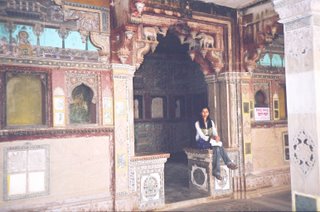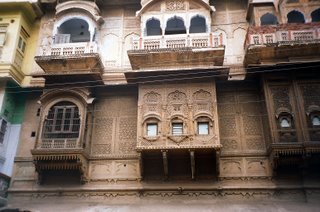
BUNDI
Bundi, a small town in southeast of Rajasthan surrounded by the Aravali Range from three sides is a center of Rajput painting that has its own style and school. A trip to Bundi would have covered the major centers of art and architecture of Rajasthan in the 18 months stay of mine in Jodhpur. So I set out on the 12th March 2006 night to board the 1
 0 o’clock bus from the Jodhpur State Roadways Bus Stand at Paota.
0 o’clock bus from the Jodhpur State Roadways Bus Stand at Paota.Bundi is also known as Harauti or Haravati, the country of the Haras, the rulers of Bundi. In the 16th century the Bundi ruler like most of the Rajput states formed alliance with Mughal Emperor Akbar and managed to flourish without contributing much to either politics of the Empire or to their own state. However, unlike other Rajput schools of painting Bundi developed early in the 16th century even in the presence of the Mughals an independent style in painting.
In 1
 193 A.D. when Sultan Mohammed Ghauri defeated Prithviraj Chauhan, some Chauhan nobles sought shelter in Mewar and became allies
193 A.D. when Sultan Mohammed Ghauri defeated Prithviraj Chauhan, some Chauhan nobles sought shelter in Mewar and became alliesto the Rana while other young warriors move towards the Chambal valley and overpowered the Meena and Bhil tribes establishing their own kingdom of Hadoti. Later, two branches of Hadas formed two separates states of Kota and Bundi, on either side of the river Chambal.
The Bundi palace is doubly fortified and the outer wall is linked to the white Taragarh (Star Fort) that was constructed in 1411 AD by Rao Raja Bar Singh, the final retreat. The fort is entered from the Hathi Pol (Elephant Gateway) that leads to a chowk (courtyard) with 8 pointed arched screens, which used to be a stable.
The Bundi palace is doubly fortified and the outer wall is linked to the white Taragarh (Star Fort) that was constructed in 1411 AD by Rao Raja Bar Singh, the final retreat. The fort is entered from the Hathi Pol (Elephant Gateway) that leads to a chowk (courtyard) with 8 pointed arched screens, which used to be a stable.
Above the stable is Ratan Daulat Hall built by Rao Ratan Singh (1607 - 31). It is also known as Diwan-I-aam as was used for Raj Tilak (coronation) ceremony. In the mid 17th century, Maharao Chatar Sal (1631 – 58) made extensive additions and built the Chatar Mahal and few apartments surrounding it. The palace room has paintings on the Pushtimarg, various themes from the life of Kŗşņa.
Above it is the Phool Mahal built by Rao Raja Bhoj (1585 – 1607). The palace was built in 1607 and has paintings on Raslila and various themes from the life of Kŗşņa. From the palace the stairs leads to the Badal Mahal built by Rao Raja Bhoj. The paintings in the Badal Mahal depict the typical square head figures that mark the Bundi School and contemporary Mughal-Rajput architecture.

It was interesting to note that there were similarities between the wall paintings in the palaces of Bundi Fort on the Pushtimarg and the paper paintings of Marwar of a later date (probably a century difference). The style lf hair tying as pointed out by Debra Diamond, Curator Freer Sackler Gallery could be the feature of the Pustimarg priest but what was noteworthy was the positing of the priests, the style the figure was drawn, the square head and body and, the lack of the typical bold Rajasthan colours.
Similarly, we see during the 19th century in Marwar the painters were using the red-orange pattern for the tents and canopies with golden floral patterns that reflect the early Bundi wall paintings in the Fort. The Marwar painters owing to the fact the marriage alliances between Marwar and Bundi may have borrowed this style, especially after Maharaja Bakht Singh (then Rajadhir
 aj of Nagaur), who was once helped by the Bundi ruler against his brother Maharaja Abhai Singh, the then ruler of Jodhpur.
aj of Nagaur), who was once helped by the Bundi ruler against his brother Maharaja Abhai Singh, the then ruler of Jodhpur. At the foot of the fort is Chitrashaal on the north. It is a courtyard with few rooms that has paintings on various themes on the avatars of Vishnu.

Bundi is a town of numerous ornate baoris(step-wells) dating back to the 17th century. Raniji ki Baori (ASI protected) with its exquisite toran archway is one of the loveliest. It has in total of 55 baoris including 7 or 8 in the fort itself.
Other Place to See
Shikar Burj
Sukh Mahal
Chauth Mata ka Mandir
Cenotaph with 84 pillars built by Bhai Deva, the brother of Bheem Rao Anirudh Singh.
84 Pillar Cenotaph
Jain temples
The old town
Baoris
AJMER
The same evening we went to Ajmer (4 ½ hour drive). Though Ajmer is known for the Hazrat Khwaja Mouinuddin Chisti Dargah and Arai-din-ka-Jhopra, what struck me was the havelis around the dargah.
Adhai-Din-Ka-Jhonpra is a remarkable structure of Indo-Islamic architecture built in two and a half days flat. This mosque was a Sanskrit college in the 12th century but in 1193 AD Mohammad Ghori destroyed the college and built a mosque in its place. It is built on pillars and surprisingly no two pillars are alike. The distinct pillars-and arched "Screen" with its ruined minarets make it a splendid architectural masterpiece. The monument has seven arched walls with Islamic calligraphy, though most of it now remains in ruins.

The archways are finely engraved with Kufi and Jughra inscriptions from the Holy Koran. The mosque has 10 domes supported by 124 pillars. These pillars depict Hindu and Jain architecture. This is a masterpiece of Indo - Islamic architecture. As legend goes its was constructed in two and a-half days (AdhAi-Din). It is a relic of an old mosque consisting of a quadrangle with a front screen wall of seven pointed arches. The distinct pillars and arched screen with its ruined minarets make it a splendid architectural masterpiece.
Beyond the Dargah, among narrow and crowded lanes, is this remarkable, early Islamic structure. Mohammed Ghori hurriedly put together a mosque within two and a half days, using the remains of several neighbouring temples. Pillars, from at least thirty temples, must have gone into the making of this elegant monument. According to another legend, the structure is named after a festival, which carried on for two and a half days.







No comments:
Post a Comment